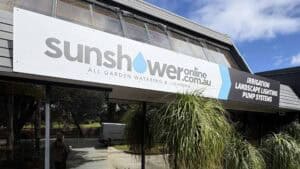Product Description
Use the Barbed Poly In-Line Filters to protect drip tube and other irrigation equipment further down the line. Without filters, drippers in drip tube especially can get blocked and dry areas start to appear in your garden. Even mains water has a little bit of grit in it and over time that can build up to cause blockages, an In-Line Filter will protect against just that.
The poly fittings we offer are high quality Antelco fittings made especially for Low Density Poly and Drip Tube. Sunshower installs these fittings on all of our irrigation installations with poly pipe or drip tube.
Antelco Poly In-Line Filters
| Antelco Poly In-Line Filter 13mm In stock SKU: FLB-FILT13 |
$8.39 |
| Antelco Poly In-Line Filter 19mm In stock SKU: FLB-FILT19 |
$10.51 |
Product Description
Use the Barbed Poly In-Line Filters to protect drip tube and other irrigation equipment further down the line. Without filters, drippers in drip tube especially can get blocked and dry areas start to appear in your garden. Even mains water has a little bit of grit in it and over time that can build up to cause blockages, an In-Line Filter will protect against just that.
The poly fittings we offer are high quality Antelco fittings made especially for Low Density Poly and Drip Tube. Sunshower installs these fittings on all of our irrigation installations with poly pipe or drip tube.





Videos



Product Specifications
| Antelco Poly In-Line Filter 13mm | Antelco Poly In-Line Filter 19mm | |
|---|---|---|
| Product Material | Poly | Poly |
| Product Colour | Black | Black |
| Product Inlet Pipe Size | 13mm Barb | 19mm Barb |
| Product Max. Inlet Pressure (kPa) | 400 | 400 |
| Product Filter Type | Plastic Mesh | Plastic Mesh |
| Product Type | Filter | Filter |
Customer Reviews
Handy Calculators
Not sure about Antelco Poly In-Line Filters for your project? We’ve built these calculators to help you! (They’re actually awesome)

Low Density Poly (LDPE), Pressure Reducers & Filters, Australian Made FAQs
The main cause of blowout is pressure. Whether it’s poly fittings, PVC fittings or timers, whatever the component, if the pressure is too high for what it’s designed for, kaboom! Simply solve the problem with a pressure reducer & make it a brass one if it’s on your water supply.
Low density poly fittings connect and branch low density polyethylene (LDPE) pipes in domestic garden and landscape irrigation systems. It’s not to be installed in constant pressure applications (eg: before irrigation valves), rather for lateral pipework in garden beds or lawns.
Low density fittings are an economical, easy to install option for non-constant pressure applications (often used in gardens and beds). While high density pipe & fittings suit constant pressure applications for mains or commercial systems, or even applications where durability & reliability are particularly important.
No, these fittings are intended only for low pressure applications (usually below 300kPa). Use high density fittings or PVC for higher pressure applications.
Cut the pipe square, push the fitting in fully, and use ratchet clamps or locking clips for a secure seal. Check for leaks before covering lines.
Yes, with the right threaded or barbed adapters, you can connect LDPE pipe to PVC, copper, or garden hose fittings.
Yes, our low density poly fittings are made from UV-stabilised materials for durability in all Australian outdoor conditions.
Poly pipe fittings connect, extend, or branch poly (polyethylene) pipes in irrigation systems, making them essential for building or repairing garden, lawn, or commercial watering setups. HDPE can be used for high pressure & even commercial applications, LDPE is suitable for small domestic, non-constant pressure applications.
We stock joiners, elbows, tees, adaptors, and more. For barbed low density poly, threaded high density poly, mechanical metric & rural fittings and electrofusion weld fittings. For all poly pipe sizes and applications.
Some yes, some no. Low density poly fittings are not suited to high pressure, whereas high density fittings can be used for both. Just be sure to check the pressure ratings before purchase and install.
Some poly pipe types & their fittings are certified for potable water, while others are irrigation-only. Always confirm certification in the product details if you need fittings for drinking water.
Yes, with the right threaded adaptors, you can connect poly pipe to PVC, copper, or threaded fittings. Browse our range of threaded fittings and adaptors for compatible solutions.
Yes, our poly fittings are made from UV-stabilised materials for long life and reliable performance in harsh Australian conditions.
Irrigation systems utilise a variety of pipes, each offering unique advantages. HDPE (high density poly) pipe is a popular choice due to its flexibility, durability and suitability for underground installation. Another standard option is the PVC pipe, valued for its corrosion resistance. Interestingly different parts of Australia, have their different preferences! For lateral pipework, LDPE (low density poly) is very popular for it’s workability & low cost. For applications requiring superior strength and durability, such as central water connections, brass fittings and valves are often preferred because they are highly resistant to corrosion and wear. Copper pipes, while less common in modern systems due to their higher cost, are still valued for their exceptional resilience from ground movement.
The size of piping depends on a number of factors, but the main one is the length of the run. Longer pipe lengths also necessitate larger diameters to minimise friction loss. Higher water pressure allows for smaller pipes, but excessively high pressure may require larger sizes to handle the force. Finally, the desired flow rate at the endpoint also influences the pipe size you’ll need. For more comprehensive assistance, please reach out to our experts.
Preventing leaks in your irrigation system starts with using the right fittings for your pipe type and adequately preparing the pipe ends for a secure connection. Apply thread tape to threaded fittings and appropriate sealant for solvent-welded connections. Tighten fittings securely, but avoid over-tightening. Regularly inspect your system for any signs of leaks to address potential issues promptly.
Yes, burying irrigation pipes underground is a common practice and offers several advantages. It protects the pipes from damage, reduces water evaporation and keeps them out of sight for a cleaner landscape aesthetic.
However, it’s crucial to choose the right type of pipe for underground installation. Polyethylene (poly) pipe is specifically designed for this purpose, thanks to its flexibility and durability. Always check local building codes and regulations for any requirements regarding underground pipe installation.
We offer a full range of fittings matched to various pipe materials and sizes. When joining from one material to another, a threaded connection is required. BSP threads are the Australian standard & that is what we sell here in Australia. Always check compatibility in the product description or ask our team for advice.
The process for repairing a leak varies depending on the type of pipe used. Often it involves cutting out the broken section, and rejoining with two suitable couplings or using a repair joiner. If threaded connections are involved, use thread seal tape and ensure seals are tight.
Potential causes include undersized pipe, leaks, blockages, or poorly fitted connections. Inspect the system, flush lines, and check for visible issues at fittings.
Pressure reducers lower incoming water pressure to levels suitable for drip irrigation, preventing damage to emitters and tubing. Filters remove dirt and debris from the water, helping to prevent clogs and ensure reliable, long-term system performance.
Yes, using both is recommended. The filter protects your emitters from clogging by debris, while the pressure reducer ensures water pressure is consistent and safe for drip components, maximising system efficiency and lifespan.
Install the filter directly after the water source or tap, followed by the pressure reducer before the main drip tubing. This setup ensures only clean, properly pressurised water enters your drip lines.
While different drip tube brands & models have different specifications, most will operate reliably between 100 kPa and 200 kPa (about 15 to 30 psi). Operating within this pressure range ensures that the emitters deliver water evenly and efficiently along the length of the drip tube without causing leaks or blowouts. Pressures that are too high can result in emitter or tubing damage, while pressures that are too low may lead to uneven water distribution. Using a pressure reducer is recommended to maintain optimal pressure for your system.
While you can lower the flow by turning down your tap, this does not reliably control water pressure for drip irrigation systems. Tap pressure can fluctuate due to changes in the main supply or other water usage in your home, which may still lead to pressure spikes that can damage drip tubing and emitters or cause uneven watering. A pressure reducer is specifically designed to maintain a consistent, safe pressure for your drip system, ensuring efficient and reliable operation.
The main cause of blowout is pressure. Whether it’s poly fittings, PVC fittings or timers, whatever the component, if the pressure is too high for what it’s designed for, kaboom! Simply solve the problem with a pressure reducer & make it a brass one if it’s on your water supply.
Drip tube is excellent in areas of rich dense soil where water spreads nicely throughout. Installed under mulch, the water is delivered with minimal evaporation & wastage, going direct to the root ball.
No, drip tube isn’t simply holes punched into poly pipe. Inside each hole is an intricate dripper which delivers that water nice and evenly. Punching a hole will simply create an uncontrolled leak!
Each sprinkler & nozzle will push out water at different rates, but the key factor is the flow rate of your water supply. Work that out with a simple timed bucket test. From there, you can work out how much water each sprinkler you’re looking at uses & work within your flow limit. For more information, check our Product Guides.
As you install a system, it’s almost inevitable that small fragments of dirt will get into the pipe, for this reason you should always flush out the system before running it the first time. This can be done by leaving an open end at the farthest point of each irrigation zone & operating the zone for 15 or so seconds to flush it out. Then plug it up & you’re good to go! This can also be said for any other times dirt may have gotten into the system (eg: further irrigation repairs or a mains water supply fault).
We definitely don’t recommend it. Typically, drip tube will deliver the water at a far slower rate that sprays. Because of this, if you were to have both on the same zone, the areas with drip would be left far drier than the areas with sprinkler coverage. If you do want to water some areas with drip & some with sprinklers, it can be done, but each will just need to be run on their own separate irrigation zones.
Even on a typical domestic system running on mains water a filter is still a good idea. In the event of a water main fault where rubbish does find it’s way down the line, a filter will protect the system from blockage and or failure. On systems operating off recycled water, like from a tank, a screen filter is mandatory. Debris like silt & dirt from recycled water is the most common cause of blockages of failures in irrigation systems.
Drip irrigation is a water-efficient system that delivers water directly to the roots of plants through a network of drip tubes or emitters. It precisely releases water at the optimal precipitation rate, minimising evaporation and runoff. This targeted approach ensures plants receive the right amount of water, promotes healthier growth and reduces water waste, making it ideal for sustainable gardening.
Drip irrigation offers numerous benefits, including:
- Water efficiency — Reduces evaporation and runoff by targeting roots directly.
- Cost savings — It uses less water and lowers bills.
- Healthier plants — Provides consistent, precise watering.
- Eco-friendly — Minimises water waste and promotes sustainability.
- Low maintenance — Fewer moving parts mean fewer repairs.
Ideal for gardens, lawns and agricultural applications, drip irrigation stands as a smart, sustainable watering solution.
To set up a drip irrigation system, plan your layout, considering plant types and spacing. Install a pressure reducer and filter at the water source. Lay drip tubing in a uniform grid throughout garden beds, securing it with pins. Finally, test the system to ensure even water distribution.
Yes, drip irrigation is ideal for both vegetable gardens and flower beds. It delivers precise, consistent water directly to plant roots, promoting healthier growth, reducing water waste, and ensuring optimal hydration for various plants and layouts.
Fully installed by a professional, a domestic irrigation system will come out to about $1000 per zone. And as a DIY project, it can look more like $300 per zone! But of course that’s a very rough estimate, each system is different and there are a lot of factors to consider. Thankfully, we have the only tool around that INSTANTLY give an accurate estimate for your. Try our INSTANT Irrigation Quote Tool here!
To choose the right irrigation system, consider the size and layout of your garden or lawn, the types of plants you’re watering and your water source. Spray systems are ideal for most applications like lawns and gardens, while drip irrigation works well for mulched garden beds and areas exposed to wind and evaporation. For expert advice tailored to your needs, request a quote from us. Or try our INSTANT Quote tool, which will give you some great recommendations!
To set up an irrigation system, start by planning the layout, then install the mainline pipes, valves and fittings. Attach the sprinklers, drip emitters or other irrigation devices, and connect the system to a controller. Finally, test and adjust the system to check for proper coverage and efficiency. For a more precise and tailored setup, visit our Design Department. Our experts can design and quote a customised irrigation system that perfectly fits your landscape.
At SunshowerOnline, we offer a wide range of irrigation systems perfect for home gardens, including spray irrigation, drip irrigation, pop-up sprinklers, micro irrigation. Just getting started? Our DIY kits make installation simple for beginners, while our expert team is available to help you design the ideal setup for your garden’s unique needs.
Our experienced Design Department can create a custom irrigation plan tailored to your property, whether you’re a homeowner, landscaper, or commercial manager. Simply provide your site details and requirements, and we’ll recommend the best products and layout for efficient, reliable watering. Need an instant quote? Try our INSTANT Quote tool!
Absolutely. We stock a comprehensive range of contractor-grade irrigation supplies, including control systems, valves, fittings, and commercial sprinklers, trusted by professionals across Australia. Bulk order discounts and trade support are available for our trade and commercial customers.
Yes, we offer step-by-step installation guides, video tutorials, and our service doesn’t stop once we a purchase is made. Expert advice over phone, chat or in-store is here to help! Whether you’re a DIY enthusiast or a professional installer, our resources make setting up your irrigation system straightforward and stress-free.
Yes, many of our irrigation products are designed for easy upgrades and retrofits. Whether you’re replacing old sprinklers, adding drip lines, or automating your watering schedule, our team can recommend compatible products and provide installation support.
To maximise the lifespan of your irrigation system, choose high-quality components, follow correct installation procedures, and perform regular maintenance such as flushing lines and checking for leaks. Our products are built to withstand Australian conditions, and our team is always here to offer ongoing support.
Yes, SunshowerOnline delivers irrigation supplies across Australia with fast, reliable shipping. Our customer service team is available to answer your questions, offer technical support, and ensure you find the right products for your project—no matter where you are located.
You might also need...
You might also like...
Need more help with Low Density Poly (LDPE), Pressure Reducers & Filters, Australian Made ? Check out these handy resources from our Help Centre

















